Does a Certain Rule Exist in the Long-Term Change of a City’s Livability? Evidence from New York, Tokyo, and Shanghai
Abstract
:1. Introduction
2. Contemporary Studies of Livability
3. Case Study Cities and Data
4. Methods
4.1. AHP Method
4.2. Measurement of Livability
5. Results and Discussion
5.1. The Variation Trend of Livability
5.2. Factor Decomposition Analysis of Livability Change
5.3. Discussion
6. Conclusions
Acknowledgments
Author Contributions
Conflicts of Interest
References
- World Bank. Putting People First: Sociological Variables in Rural Development; Oxford University Press: Oxford, UK, 1985. [Google Scholar]
- Turner, J. Human Institutions: A Theory of Societal Evolution; Rowman & Littlefield: Lanham, MD, USA, 2003. [Google Scholar]
- The World Bank. Social Development: Putting People First. Available online: http://siteresources.worldbank.org/INTRANETSOCIALDEVELOPMENT/Resources/SDN_Results_Social_Development.pdf (accessed on 29 July 2017).
- Jones, L.L. Benchmarking the Future World of Cities. Available online: http://www.jll.com/Research/jll-business-of-cities-report-april-2016.pdf (accessed on 4 September 2017).
- Marsal-Llacuna, M.L.; Colomer-Llinàs, J.; Meléndez-Frigola, J. Lessons in urban monitoring taken from sustainable and livable cities to better address the smart cities initiative. Technol. Forecast. Soc. 2015, 90, 611–622. [Google Scholar] [CrossRef]
- Bibri, S.E.; Krogstie, J. Smart sustainable cities of the future: An extensive interdisciplinary literature review. Sustain. Cities Soc. 2017, 31, 183–212. [Google Scholar] [CrossRef]
- Wheeler, S.M. Planning for Sustainability: Creating Livable, Equitable and Ecological Communities; Routledge: London, UK, 2013. [Google Scholar]
- Lee, J.H.; Hancock, M.G.; Hu, M.C. Towards an effective framework for building smart cities: Lessons from Seoul and San Francisco. Technol. Forecast. Soc. 2014, 89, 80–99. [Google Scholar] [CrossRef]
- Wei, Y.G.; Huang, C.; Lam, P.T.I.; Yuan, Z. Sustainable urban development: A review on urban carrying capacity assessment. Habitat Int. 2015, 46, 64–71. [Google Scholar] [CrossRef]
- Chourabi, H.; Nam, T.; Walker, S.; Gilgarcia, J.R.; Mellouli, S.; Nahon, K.; Pardo, T.A.; Scholl, H.J. Understanding Smart Cities: An Integrative Framework. In Proceedings of the 45th Hawaii International Conference on System Science, Maui, HI, USA, 4–7 January 2012. [Google Scholar]
- UN-Habitat. State of the World’s Cities 2010/11: Cities for All: Bridging the Urban Divide; Routledge: London, UK, 2010. [Google Scholar]
- Rengasamy, S. Understanding Urbanization and Urban Community Development. Available online: http://zh.scribd.com/doc/21976896/Understanding-UrbanizationUrban-Community-Development (accessed on 1 June 2015).
- Manning, W. Urban environment: Recognizing that pollution and social factors can create barriers to development of more healthy and livable cities. Environ. Pollut. 2013, 183, 1. [Google Scholar] [CrossRef] [PubMed]
- Lerner, J. Essay: New York 2013: Towards a more livable city. Archit. Urban. 2013, 5, 48–50. [Google Scholar]
- Florida, R. Who’s your city? How the creative economy is making where to live the most important decision of your life. Contemp. Sociol. 2010, 39, 701–703. [Google Scholar]
- Okulicz-Kozaryn, A. City life: Rankings (livability) versus perceptions (satisfaction). Soc. Indic. Res. 2013, 110, 433–451. [Google Scholar] [CrossRef]
- McDonnell, M.; McGregor-Fors, M. The ecological future of cities. Science 2016, 352, 936–937. [Google Scholar] [CrossRef] [PubMed]
- Bibri, S.E.; Krogstie, J. On the social shaping dimensions of smart sustainable cities: A study in science, technology, and society. Sustain. Cities Soc. 2017, 29, 219–246. [Google Scholar] [CrossRef]
- Yang, F.; Zhang, X. Planning for sustainable cities? A comparative content analysis of the master plans of eco, low-carbon and conventional new towns in China. Habitat Int. 2017, 63, 55–66. [Google Scholar]
- The Economist Intelligence Unit (EIU). A Summary of the Livability Ranking and Overview. 2016. Available online: http://www.eiu.com (accessed on 14 September 2016).
- Monocle. The Liveable Cities Index 2011—Global. Available online: https://monocle.com/magazine/issues/45/the-liveable-cities-index-2011 (accessed on 20 September 2017).
- Tan, K.G.; Thye, W.W. A new approach to measuring the liveability of cities: The global liveable cities index. World Rev. Sci. Technol. Sustain. Dev. 2014, 11, 176–196. [Google Scholar]
- Andersen, M.; Reilly, S.; Siscovick, M. Mercer’s 19th Quality of Living Ranking. Available online: https://www.mercer.com/newsroom/2017-quality-of-living-survey.html (accessed on 4 September 2017).
- Numbeo. Quality of Life Index 2017 Mid-Year. 2017. Available online: https://www.numbeo.com/quality-of-life/rankings.jsp (accessed on 4 September 2017).
- Li, W.Y.; Yao, C.C. Trends of livability in the capital region of Taiwan. J. Asian Archit. Build. Eng. 2013, 12, 293–300. [Google Scholar] [CrossRef]
- World Commission on Environment and Development (WCED). Our Common Future; Oxford University Press: New York, NY, USA, 2001. [Google Scholar]
- United Nations Environment Programme (UNEP). Climate Change 2001: Synthesis Report. 2001. Available online: http://www.ipcc.ch/ipccreports/tar/vol4/pdf/front.pdf (accessed on 22 March 2016).
- United Nations Human Settlements Programme (UN-Habitat). Planning Sustainable Cities: Global Report on Human Settlements; Earthscan: London, UK, 2009. [Google Scholar]
- Vuchic, V. Transportation for Livable Cities; Routledge: London, UK, 1999. [Google Scholar]
- Zanella, A.; Camanho, A.S.; Dias, T.G. The assessment of cities’ livability integrating human wellbeing and environmental impact. Ann. Oper. Res. 2014, 226, 695–726. [Google Scholar] [CrossRef]
- America Association of Retired Persons (ARRP). ARRP Livability Index. Available online: https://livabilityindex.aarp.org (accessed on 4 September 2017).
- CNN Money. An Assessment of the Best Places to Live in America. 2005. Available online: http://money.cnn.com (accessed on 14 September 2014).
- Zhang, W.Z. Index system and method of residential environmental evaluation in inner cities. Sci. Geogr. Sin. 2007, 27, 17–23. (In Chinese) [Google Scholar]
- Sassen, S. The Global City: New York, London, Tokyo; Princeton University Press: Princeton, NJ, USA, 2001. [Google Scholar]
- The Tokyo Metropolitan Government. Creating the Future: The Long-Term Vision for Tokyo. Available online: http://www.metro.tokyo.jp (accessed on 22 March 2015).
- The New York City Government. One New York: The Plan for a Strong and Just City. Available online: http://www1.nyc.gov (accessed on 22 March 2015).
- Shanghai Municipal Government. The 13th Five-Year Plan for Economic and Social Development of Shanghai. Available online: http://www.shanghai.gov.cn (accessed on 22 March 2015).
- Yigitcanlar, T.; Dur, F.; Dizdaroglu, D. Towards prosperous sustainable cities: A multiscalar urban sustainability assessment approach. Habitat Int. 2015, 45, 36–46. [Google Scholar] [CrossRef]
- Gu, W.X.; Luo, Y.M. Livable city scientific evaluation criteria. Beijing City Plan. Constr. Rev. 2007, 1, 7–10. [Google Scholar]
- Wang, S.Y.; Zhu, D.; Zang, M.D. Getting out of the paradox of livable city researches: Conceptual model and choice of path. Urban Plan. Forum 2010, 23, 42–48. [Google Scholar]
- Malecki, E. The economic geography of the internet’s infrastructure. Econ. Geogr. 2002, 78, 399–424. [Google Scholar] [CrossRef]
- Jorgenson, D.W.; Khuon, V. Information technology and the world economy. Scand. J. Econ. 2005, 107, 631–650. [Google Scholar] [CrossRef]
- Rainie, L. How the internet will change the world—Even more. Sci. News 2010, 177, 53–64. [Google Scholar] [CrossRef]
- City of London. The London Plan: The Spatial Development Strategy for London Consolidated with Alterations Since 2011. Available online: http://www.cityoflondon.gov.uk (accessed on 22 March 2015).
- Saaty, T.L. Models, Methods, Concepts Applications of the Analytic Hierarchy Process; Springer: New York, NY, USA, 2012. [Google Scholar]
- Saaty, T.L. Decision-making with the AHP: Why is the principal eigenvector necessary. Eur. J. Oper. Res. 2003, 145, 85–91. [Google Scholar] [CrossRef]
- Lankevich, G.J. New York City: A Short History; New York University Press: New York, NY, USA, 2002. [Google Scholar]
- Shimizu, C.; Nishimura, K.G. Pricing structure in Tokyo metropolitan land markets and its structural changes: Pre-bubble, bubble, and post-bubble periods. J. Real Estate Financ. Econ. 2007, 35, 475–496. [Google Scholar] [CrossRef]
- United Nations (UN). Department of Economic and Social Affairs: Population Division. Available online: http://www.un.org/en/development/desa/population (accessed on 2 June 2015).
- Kennedy, C.; Steinberger, J.; Gasson, B.; Hansen, Y.; Hillman, T.; Havránek, M.; Pataki, D.; Phdungsilp, A.; Ramaswami, A.; Mendez, G.V. Greenhouse gas emissions from global cities. Environ. Sci. Technol. 2009, 43, 7297–7302. [Google Scholar] [CrossRef] [PubMed]
- Li, L.; Chen, C.; Xie, S.; Huang, C.; Cheng, Z.; Wang, H.; Wang, Y.; Huang, H.; Lu, J.; Dhakal, S. Energy demand and carbon emissions under different development scenarios for Shanghai, China. Energ. Policy 2010, 38, 4797–4807. [Google Scholar] [CrossRef]
- Dhakal, S. GHG emissions from urbanization and opportunities for urban carbon mitigation. Curr. Opin. Environ. Sustain. 2010, 2, 277–283. [Google Scholar] [CrossRef]
- International Energy Agency (IEA). World Energy Outlook. 2008. Available online: http://www.worldenergyoutlook.org (accessed on 22 March 2015).
- Shiva Nagendra, S.M.; Diya, M.; Chithra, V.S.; Menon, J.S.; Peter, A.E. Characteristics of air pollutants at near and far field regions of a national highway located at an industrial complex. Transp. Res. Part D Trans. Env. 2016, 48, 1–13. [Google Scholar] [CrossRef]
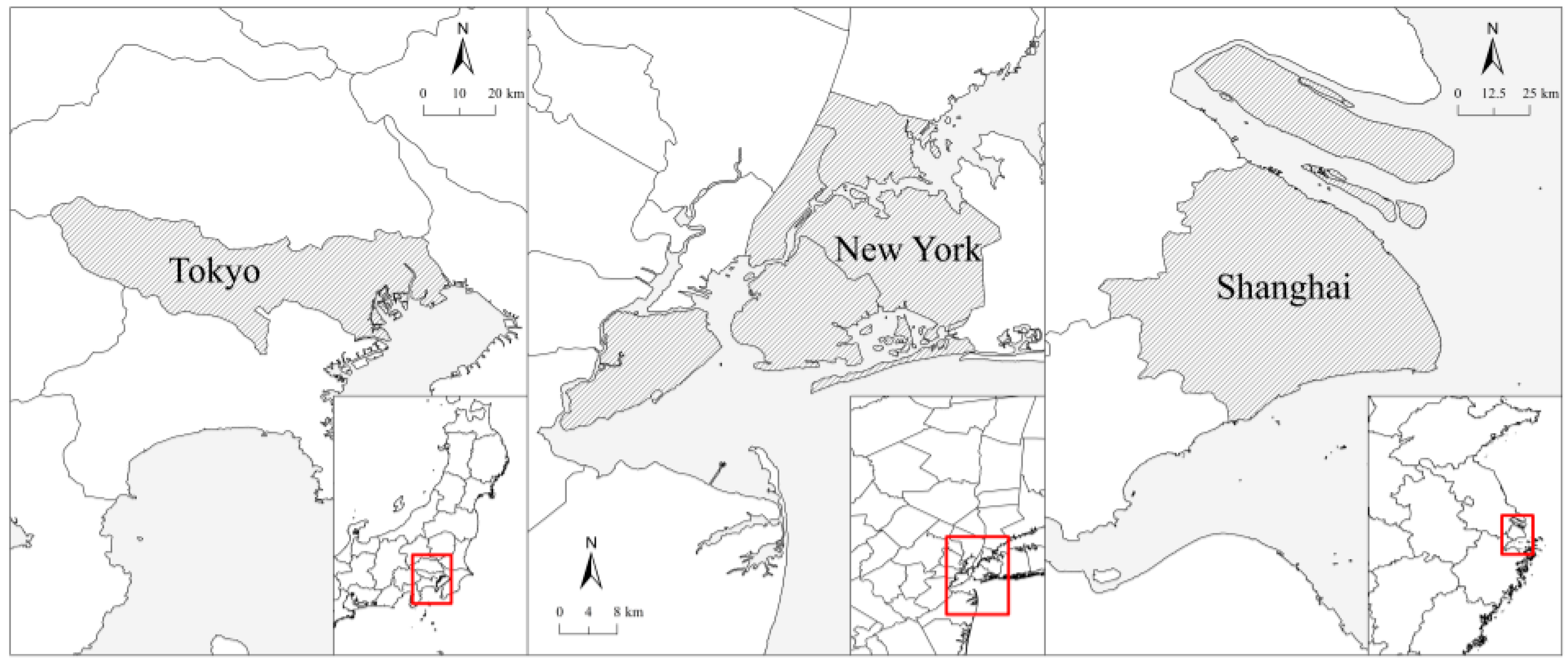
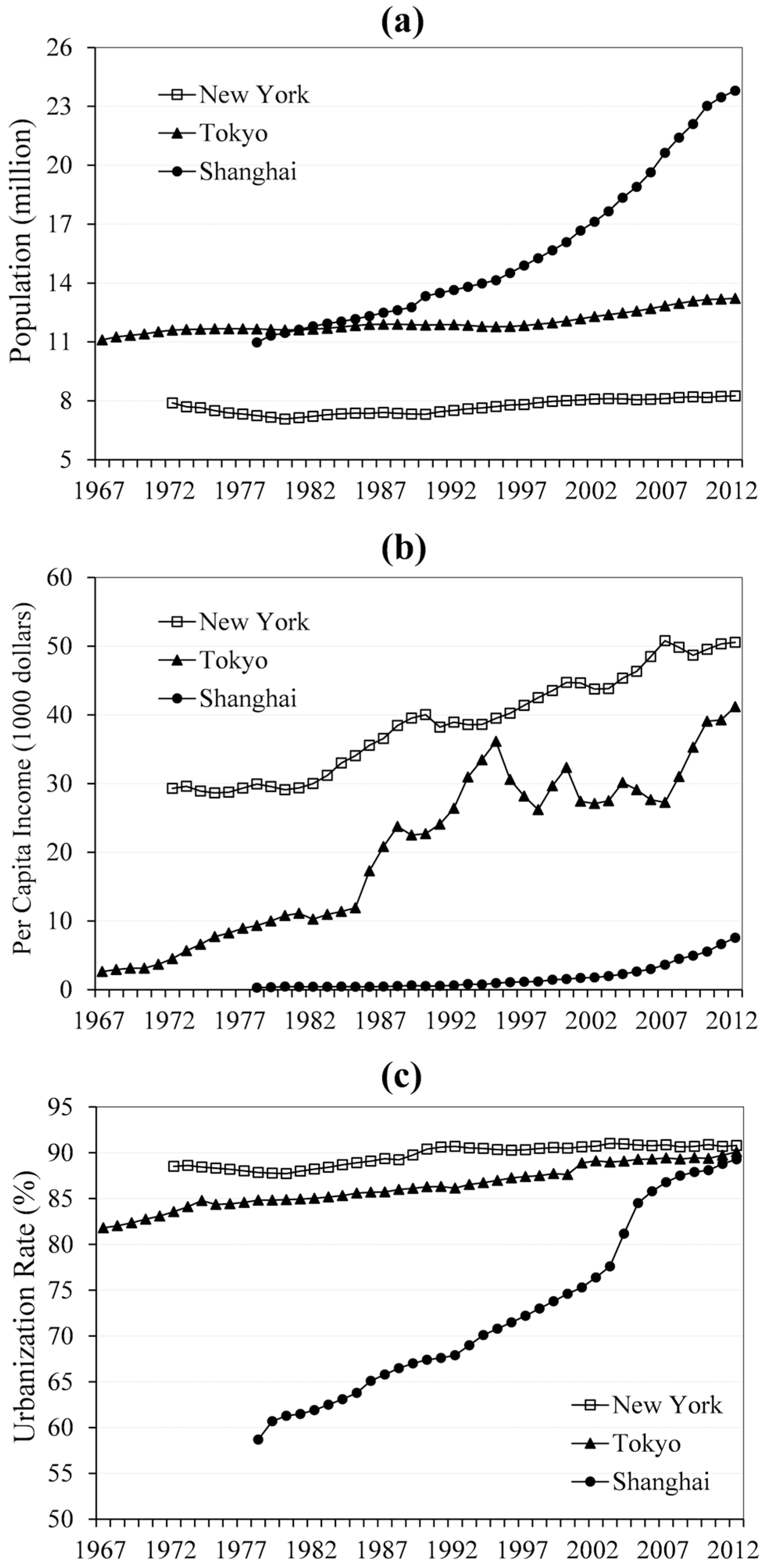
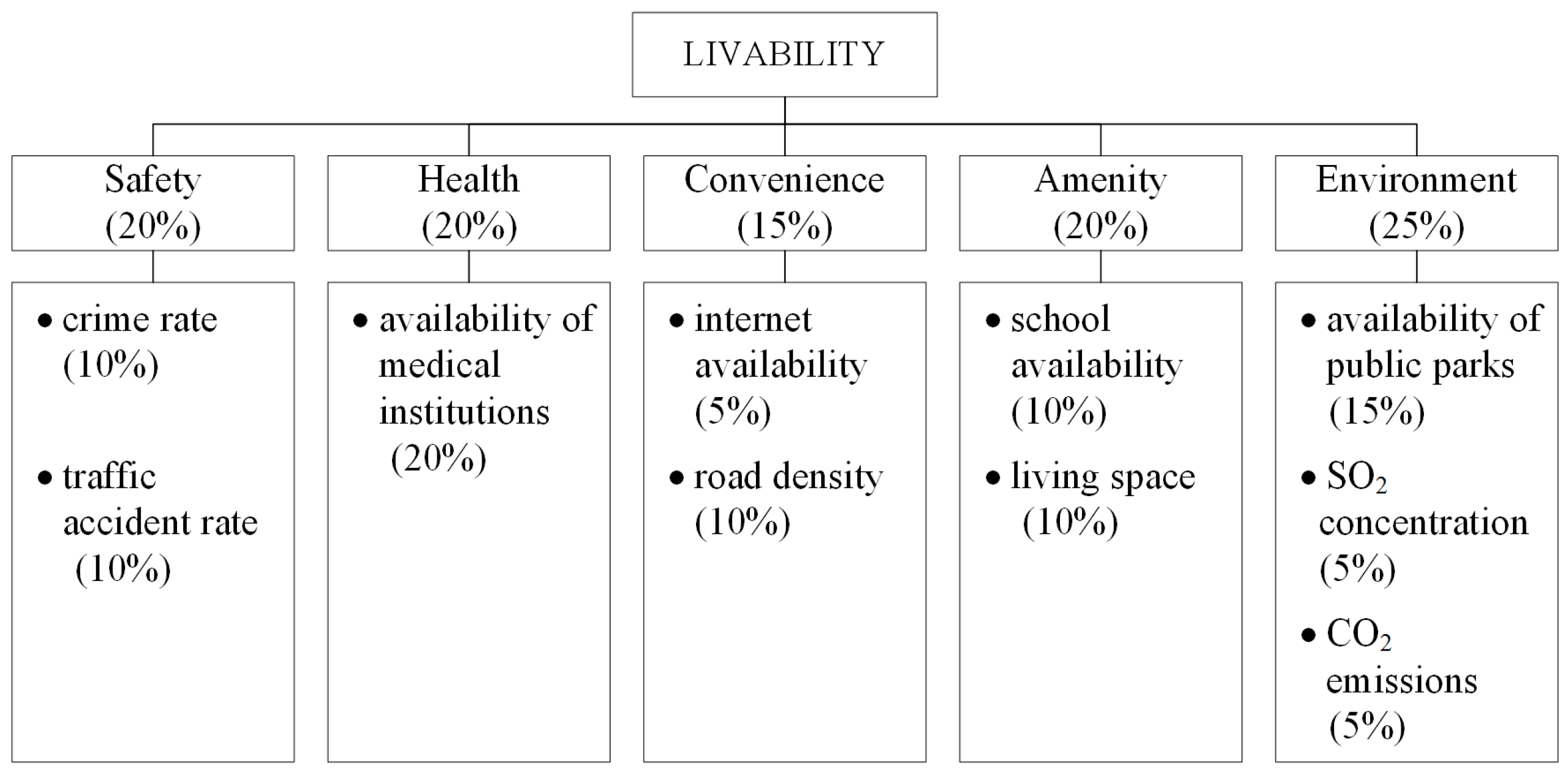
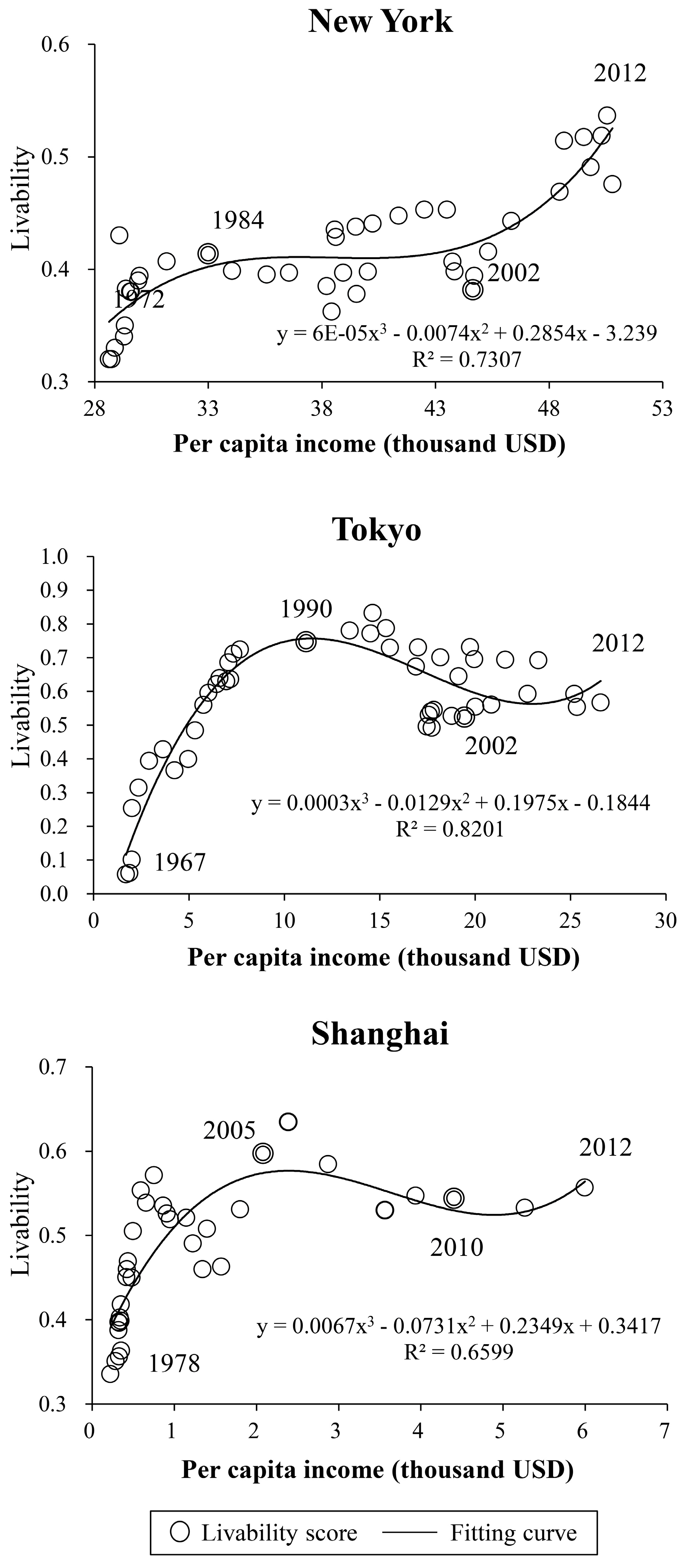
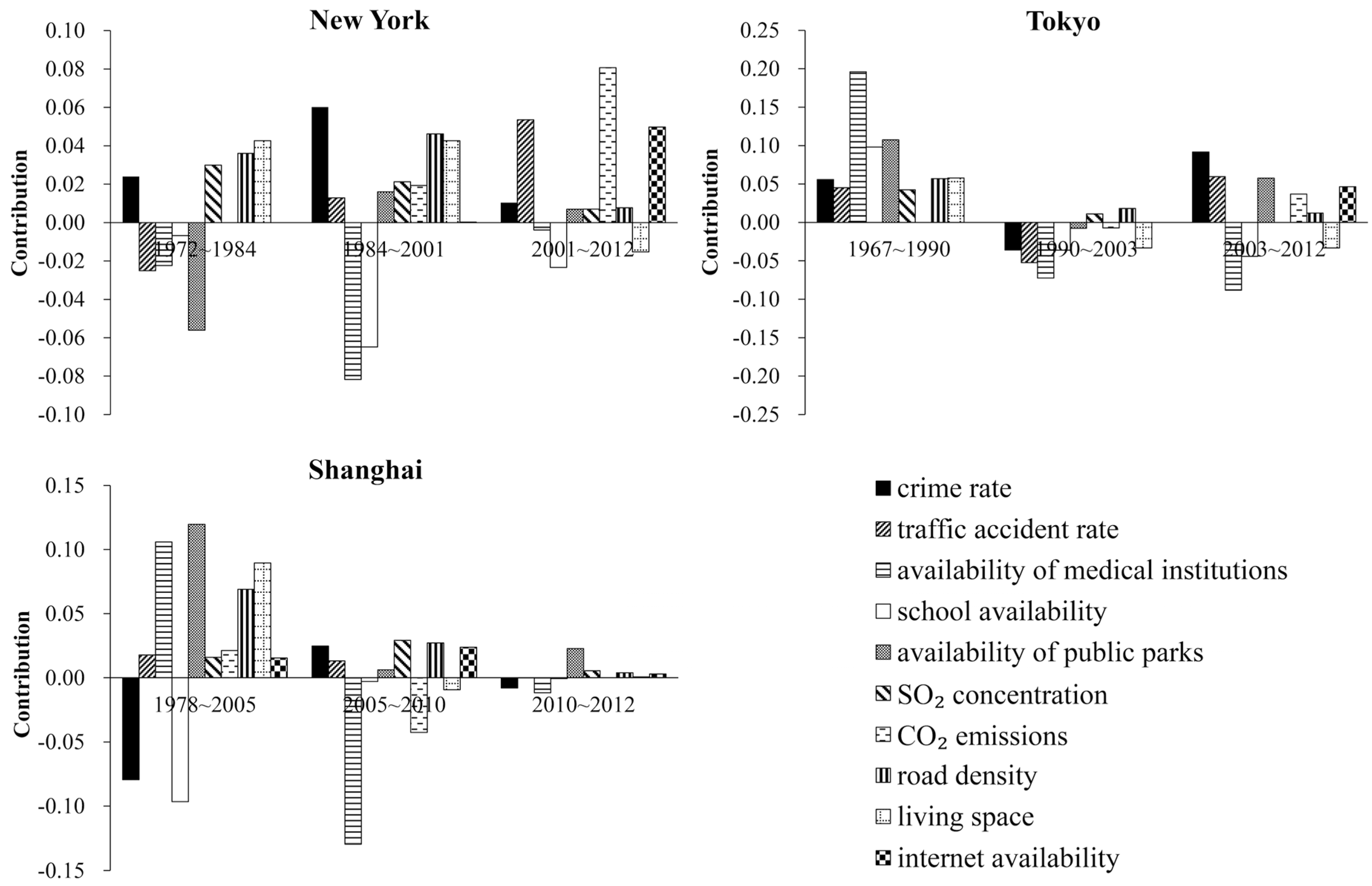
| Researcher or Institute | Study Area | Indicators Employed |
|---|---|---|
| UNEP (1989) | Cities in the world | Housing, infrastructure, transformation of the old city, sustainable human settlements development, reconstruction, housing difficulties. |
| CNN (Cable News Network) Money (2005) [32] | USA | Financial position, housing, educational level, quality of life, cultural and recreational facilities, climate condition. |
| Ministry of Construction (2007) | China | Degree of social civilization, economic prosperity, environmental beauty, resources carrying capacity, convenience and comfort of living, the degree of public safety. |
| Zhang et al. (2007) [33] | 30 cities in China | Living conditions, life improvement, cost of living, convenience, human capital, environment. |
| Monocle (2011) [21] | Cities around the world | Openness, security, convenience of service facilities, comfort, tolerance of environment. |
| Li et al. (2013) [25] | 23 cities and counties in Taiwan | Convenience, comfort, housing, safety, construction and development, expenditures and housing, food and plumbing. |
| Zanella et al. (2014) [30] | 34 cities in Europe | Housing quality, accessibility and transportation, human health, economic and social development, education, culture and leisure, solid waste, air pollutants. |
| Tan and Thye (2014) [22] | 64 global cities | Economic vibrancy and competitiveness, environmental friendliness and sustainability, domestic security and stability, socio-cultural conditions and political governance |
| EIU (2016) [20] | Cities in the world | Stability, healthcare, culture, environment, education, infrastructure. |
| Mercer (2017) [23] | 231 cities around the world | Political and social environment, economic environment, socio-cultural environment, medical and health considerations, schools and education, public services and transportation, recreation, consumer goods, housing and natural environment. |
| ARRP (2017) [31] | Communities in the USA | Housing, neighborhood, transportation, environment, health, engagement and opportunity. |
| Numbeo (2017) [24] | Cities around the world | Cost of living and purchasing power, affordability of housing, pollution, crime rates, health system quality, traffic. |
| Scale | Definition | Note |
|---|---|---|
| 1 | Not at all important | i is equally important to j |
| 3 | Slightly important | i is moderately important to j |
| 5 | Fairly important | i is essentially important to j |
| 7 | Essentially important | i is very strongly important to j |
| 9 | Absolute important | i is very absolutely important to j |
| 2, 4, 6, 8 | Intermediate value | The relative importance of i to j is between two adjacent judgment |
| n | 1 | 2 | 3 | 4 | 5 | 6 | 7 | 8 | 9 |
|---|---|---|---|---|---|---|---|---|---|
| RI | 0 | 0 | 0.58 | 0.90 | 1.12 | 1.24 | 1.32 | 1.41 | 1.45 |
© 2017 by the authors. Licensee MDPI, Basel, Switzerland. This article is an open access article distributed under the terms and conditions of the Creative Commons Attribution (CC BY) license (http://creativecommons.org/licenses/by/4.0/).
Share and Cite
Liu, J.; Han, J. Does a Certain Rule Exist in the Long-Term Change of a City’s Livability? Evidence from New York, Tokyo, and Shanghai. Sustainability 2017, 9, 1681. https://doi.org/10.3390/su9101681
Liu J, Han J. Does a Certain Rule Exist in the Long-Term Change of a City’s Livability? Evidence from New York, Tokyo, and Shanghai. Sustainability. 2017; 9(10):1681. https://doi.org/10.3390/su9101681
Chicago/Turabian StyleLiu, Jiabin, and Ji Han. 2017. "Does a Certain Rule Exist in the Long-Term Change of a City’s Livability? Evidence from New York, Tokyo, and Shanghai" Sustainability 9, no. 10: 1681. https://doi.org/10.3390/su9101681
APA StyleLiu, J., & Han, J. (2017). Does a Certain Rule Exist in the Long-Term Change of a City’s Livability? Evidence from New York, Tokyo, and Shanghai. Sustainability, 9(10), 1681. https://doi.org/10.3390/su9101681






